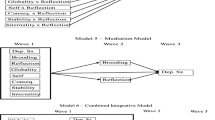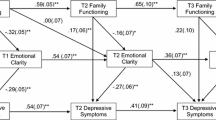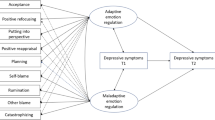Abstract
Adolescence is a period of human development associated with increased emotional intensity and heightened vulnerability to developing psychopathology. This study used Latent Class Analysis to identify subgroups of youth based on emotional clarity and cognitive response styles. Participants were 436 adolescents (51.8% female; 48.2% African-American/Black, 47.4% Caucasian/White) who completed measures of emotional clarity, cognitive response styles, and depression at baseline (M = 13.02 years, SD = .83), and at a 1-year and 4-year follow-up. Four classes were identified and used to predict depression outcomes. Overall, youth with above average emotional clarity who reported using a variety of adaptive cognitive response styles also had the lowest level of depressive symptoms at baseline. Class membership did not predict depressive symptoms at any follow-up. The results suggest that the unique profiles based on youth reported levels of emotional clarity and use of problem solving, distraction, and rumination, may not be more predictive of depression outcomes, beyond earlier assessments of depression or by examining these facets in isolation.

Similar content being viewed by others
Notes
To constrain individuals to their most likely class, the logits for the classification probabilities for the most likely latent class membership obtained in the first stage of data analysis were entered as parameters for each class.
References
Abela, J. R. Z., Aydin, C. M., & Auerbach, R. P. (2007). Responses to depression in children: Reconceptualizing the relation among response styles. Journal of Abnormal Child Psychology, 35(6), 913–927.
Abela, J. R. Z., & Hankin, B. L. (2011). Rumination as a vulnerability factor to depression during the transition from early to middle adolescence: A multiwave longitudinal study. Journal of Abnormal Psychology, 120(2), 259–271.
Abela, J. R. Z., Vanderbilt, E., & Rochon, A. (2004). A test of the integration of the response styles and social support theories of depression in third and seventh grade children. Journal of Social and Clinical Psychology, 23(5), 653–674.
Abramson, L. Y., Metalsky, G. I., & Alloy, L. B. (1989). Hopelessness depression: A theory-based subtype of depression. Psychological Review, 96, 358–372.
Alloy, L. B., & Abramson, L. Y. (2007). The adolescent surge in depression and emergence of gender differences: A biocognitive vulnerability-stress model in developmental context. In D. Romer & E. F. Walker (Eds.), Adolescent psychopathology and the developing brain: Integrating brain and prevention science. Oxford: Oxford University Press.
Alloy, L. B., Black, S. K., Young, M. E., Goldstein, K. E., Shapero, B. G., Stange, J. P., et al. (2012). Cognitive vulnerabilities and depression versus other psychopathology symptoms and diagnoses in early adolescence. Journal of Clinical Child and Adolescent Psychology, 41, 539–560.
Asparouhov, T., & Muthén, B. (2014). Auxiliary variables in mixture modeling: Three-step approaches using Mplus. Structural Equation Modeling: A Multidisciplinary Journal, 21(3), 329–341.
Beck, A. T. (1967). Depression: Clinical, experimental, and theoretical aspects. Philadelphia, PA: University of Pennsylvania Press.
Brinthaupt, T. M., & Lipka, R. P. (2002). Understanding early adolescent self and identity: An introduction. In R. P. Lipka & T. M. Brinthaupt (Eds.), Understanding early adolescent self and identity: Applications and interventions (pp. 1–21). Albany, NY: State University of New York Press.
Cañas, J. J., Quesada, J. F., Antolí, A., & Fajardo, I. (2003). Cognitive flexibility and adaptability to environmental changes in dynamic complex problem-solving tasks. Ergonomics, 46(5), 482–501.
Chang, E. C., D’Zurilla, T. J., & Sanna, L. J. (Eds.). (2004). Social problem solving: Theory, research, and training. Washington, D.C.: American Psychological Association.
Cheng, C., Lau, H., & Chan, M. (2014). Coping flexibility and psychological adjustment to stressful life changes: A meta-analytic review. Psychological Bulletin, 140, 1582–1607.
Davis, R. N., & Nolen-Hoeksema, S. (2000). Cognitive inflexibility among ruminators and nonruminators. Cognitive Therapy and Research, 24(6), 699–711.
Denham, S. A. (2007). Dealing with feelings: How children negotiate the worlds of emotions and social relationships. Cognition, Brain, Behavior, 11(1), 1.
Eastabrook, J. M., Flynn, J. J., & Hollenstein, T. (2014). Internalizing symptoms in female adolescents: Associations with emotional awareness and emotion regulation. Journal of Child and Family Studies, 23(3), 487–496.
Extremera, N., Durán, A., & Rey, L. (2007). Perceived emotional intelligence and dispositional optimism–pessimism: Analyzing their role in predicting psychological adjustment among adolescents. Personality and Individual Differences, 42(6), 1069–1079.
Flynn, M., & Rudolph, K. D. (2010). The contribution of deficits in emotional clarity to stress responses and depression. Journal of Applied Developmental Psychology, 31(4), 291–297.
Fossati, A., Feeney, J., Maffei, C., & Borroni, S. (2014). Thinking about feelings: Affective state mentalization, attachment styles, and borderline personality disorder features among Italian nonclinical adolescents. Psychoanalytic Psychology, 31(1), 41–67.
Fredrickson, B. L. (2004). The broaden-and-build theory of positive emotions. Philosophical Transactions of the Royal Society B, 359, 1367–1377.
Fresco, D. M., Williams, N. L., & Nugent, N. R. (2006). Flexibility and negative affect: Examining the associations of explanatory flexibility and coping flexibility to each other and to depression and anxiety. Cognitive Therapy and Research, 30, 201–210.
Ge, X., Lorenz, F. O., Conger, R. D., Elder, G. H., & Simons, R. L. (1994). Trajectories of stressful life events and depressive symptoms during adolescence. Developmental Psychopathology, 30, 467–483.
Gohm, C. L., & Clore, G. L. (2000). Individual differences in emotional experience: Mapping available scales to processes. Personality and Social Psychology Bulletin, 26(6), 679–697.
Goodman, S. H., Gravitt, G. W., & Kaslow, N. J. (1995). Social problem solving: A moderator of the relation between life stress and depression symptoms in children. Journal of Abnormal Child Psychology, 23, 473–485.
Gross, J. J., & Thompson, R. A. (2007). Emotion regulation: Conceptual foundations. In J. J. Gross (Ed.), Handbook of emotion regulation (pp. 3–24). New York: Guilford Press.
Hankin, B. L., Abramson, L. Y., Moffitt, T. E., Silva, P. A., McGee, R., & Angell, K. E. (1998). Development of depression from preadolescence to young adulthood: Emerging gender differences in a 10-year longitudinal study. Journal of Abnormal Psychology, 107(1), 128.
Hankin, B. L., Mermelstein, R., & Roesch, L. (2007). Sex differences in adolescent depression: Stress exposure and reactivity models. Child Development, 78, 279–295.
Hyde, J. S., Mezulis, A. H., & Abramson, L. Y. (2008). The ABCs of depression: Integrating affective, biological, and cognitive models to explain the emergence of the gender difference in depression. Psychological Review, 115(2), 291.
Kashdan, T. B., & Rottenberg, J. (2010). Psychological flexibility as a fundamental aspect of health. Clinical Psychological Review, 30, 865–878.
Klein, D. N., Dougherty, L. R., & Olino, T. M. (2005). Toward guidelines for evidence-based assessment of depression in children and adolescents. Journal of Clinical Child and Adolescent Psychology, 34, 412–432.
Kovacs, M. (1985). The children’s depression inventory (CDI). Psychopharmacology Bulletin, 21(4), 995–998.
Kovacs, M. (1992). The children’s depression inventory: Manual. North Tonawanda, NY: Multi-Health Systems.
Masyn, K. E., Henderson, C. E., & Greenbaum, P. E. (2010). Exploring the latent structures of psychological constructs in social development using the dimensional/categorical spectrum. Social Development, 19, 470–493.
McLaughlin, K. A., Garrad, M. C., & Somerville, L. H. (2015). What develops during emotional development? A component process approach to identifying sources of psychopathology risk in adolescence. Dialogues in Clinical Neuroscience, 17(4), 403.
McLaughlin, K. A., & Nolen-Hoeksema, S. (2011). Rumination as a transdiagnostic factor in depression and anxiety. Behaviour Research and Therapy, 49(3), 186–193.
Muris, P., Roelofs, J., Meesters, C., & Boomsma, P. (2004). Rumination and worry in nonclinical adolescents. Cognitive Therapy and Research, 28, 539–554.
Muthén, L. K., & Muthén, B. O. (1998–2015). Mplus user’s guide (7th ed.). Los Angeles, CA: Muthén & Muthén.
Nolen-Hoeksema, S. (1991). Responses to depression and their effects on the duration of the depressive episode. Journal of Abnormal Psychology, 100, 569–582.
Nolen-Hoeksema, S., & Girgus, J. S. (1994). The emergence of gender differences in depression during adolescence. Psychological bulletin, 115(3), 424.
Nolen-Hoeksema, S., & Morrow, J. (1993). Effects of rumination and distraction on naturally occurring depressed mood. Cognition and Emotion, 7, 561–570.
Nylund, K. L., Asparouhov, T., & Muthén, B. O. (2007). Deciding on the number of classes in latent class analysis and growth mixture modeling: A Monte Carlo simulation study. Structural Equation Model: A Multidisciplinary Journal, 14, 535–569.
Oliva, A., Parra, Á, & Reina, M. C. (2014). Personal and contextual factors related to internalizing problems during adolescence. Child & Youth Care Forum, 43(4), 505–520.
Powell, S., Coll, K. M., Trotter, A., Thobro, P., & Haas, R. (2011). Psychosocial correlates of alexithymia in a rural adolescent residential population. Residential Treatment for Children & Youth, 28(4), 327–344.
Rubenstein, L. M., Hamilton, J. L., Stange, J. P., Flynn, M., Abramson, L. Y., & Alloy, L. B. (2015). The cyclical nature of depressed mood and future risk: Depression, rumination, and deficits in emotional clarity in adolescent girls. Journal of Adolescence, 42, 68–76.
Salovey, P., & Mayer, J. D. (1990). Emotional intelligence. Imagination, Cognition and Personality, 9, 185–211.
Salovey, P., Mayer, J. D., Goldman, S. L., Turvey, C., & Palfai, T. P. (1995). Emotional attention, clarity, and repair: Exploring emotional intelligence using the trait meta-mood scale. In J. Pennebaker (Ed.), Emotion, disclosure, and health. Washington, DC: American Psychological Association.
Schwartz, J. A. J., & Koenig, L. J. (1996). Response styles and negative affect among adolescents. Cognitive Therapy and Research, 20, 13–36.
Stange, J. P., Alloy, L. B., & Fresco, D. M. (2017). Inflexibility as a vulnerability to depression: A systematic qualitative review. Clinical Psychology: Science and Practice, 24, 245–276.
Stange, J. P., Connolly, S. L., Burke, T. A., Hamilton, J. L., Hamlat, E. J., Abramson, L. Y., & Alloy, L. B. (2016). Inflexible cognition predicts first onset of major depressive episodes in adolescence. Depression and Anxiety, 33, 1005–1012.
Steffen, P. R., Elliott, C. H., Lassen, M. K., Olsen, J., & Smith, L. L. (2016). Expanding schema conceptualization and assessment: Towards a richer understanding of adaptive and maladaptive functioning. Australian Journal of Psychology. https://doi.org/10.1111/ajpy.12141.
Steinberg, L. (2017). Adolescence (11th ed.). New York: McGraw-Hill Education.
Troy, A. S., & Mauss, I. B. (2011). Resilience in the face of stress: Emotion regulation as a protective factor. In S. M. Southwick et al. (Eds.), Resilience and mental health (pp. 30–44). Cambridge: Cambridge University Press.
Twenge, J. M., & Nolen-Hoeksema, S. (2002). Age, gender, race, socioeconomic status, and birth cohort difference on the children’s depression inventory: A meta-analysis. Journal of Abnormal Psychology, 111(4), 578–588.
Funding
This research was supported by National Institute of Mental Health Grants MH79369 and MH101168 to Lauren B. Alloy. Brae Anne McArthur was supported by a Banting Postdoctoral Fellowship from the Social Sciences and Humanities Research Council. Taylor A. Burke was supported by a National Science Foundation Graduate Student Research Fellowship.
Author information
Authors and Affiliations
Corresponding author
Ethics declarations
Conflict of Interest
Brae Anne McArthur, Liza M. Haas, Taylor A. Burke, Lisa E. Johnson, Thomas M. Olino, Lyn Y. Abramson and Lauren B. Alloy declare that they have no conflicts of interest.
Informed Consent
All procedures performed in studies involving human participants were in accordance with the ethical standards of the institutional and/or national research committee and with the 1964 Helsinki declaration and its later amendments or comparable ethical standards. Informed consent was obtained from all individual participants included in the study.
Animal Rights
This article does not contain any studies with animals performed by any of the authors.
Rights and permissions
About this article
Cite this article
McArthur, B.A., Haas, L.M., Burke, T.A. et al. Understanding the Constellation of Adolescent Emotional Clarity and Cognitive Response Styles when Predicting Depression: A Latent Class Analysis. Cogn Ther Res 42, 803–812 (2018). https://doi.org/10.1007/s10608-018-9930-9
Published:
Issue Date:
DOI: https://doi.org/10.1007/s10608-018-9930-9




